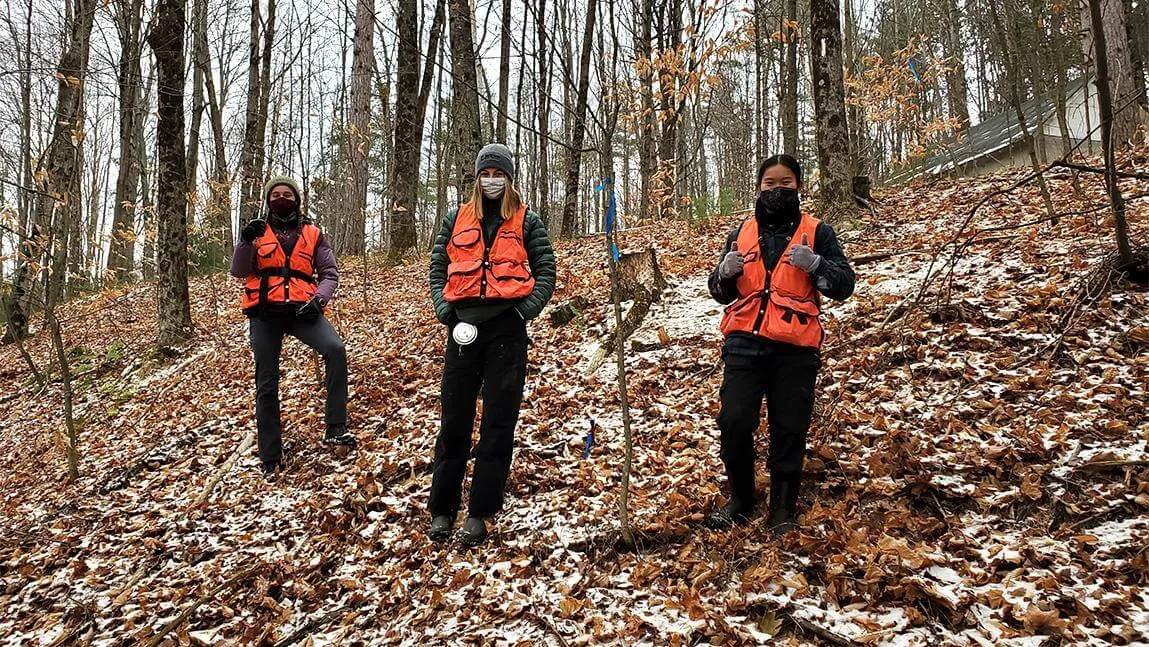The University of Vermont (UVM) Rubenstein School of Environment and Natural Resources has established 464 permanent monitoring plots on UVM Forests. During the summers of 2019 and 2020, a total of nine students worked with Ralph Tursini, Rubenstein School forest coordinator, and used surveying and mapping equipment, including hip chains, siting compasses, and GPS, to locate the one-fifth-acre plots.
The University of Vermont (UVM) Rubenstein School of Environment and Natural Resources has established 464 permanent monitoring plots on UVM Forests. The Vermont properties—Jericho Research Forest in the town of Jericho, Talcott Forest in Williston, Wolcott Research Forest in Wolcott, and Washington Forest in Washington—are owned by UVM and managed by the Rubenstein School.
The Continuous Forest Inventory (CFI) plots, installed during the summers of 2019 and 2020, will be re-visited each decade, beginning in the summer of 2021, to collect data and monitor changes in tree age and health, tree species composition, carbon sequestration, and other forest ecosystem attributes.
CFI plots are permanent monitoring points designed to help managers assess and track changes over time in forest ecological conditions and processes, such as tree growth, mortality, and regeneration. Networks of CFI plots, like those established as part of the USDA Forest Service Forest Inventory and Analysis (FIA) program, help to document impacts of changing climate and disturbances on forest ecological conditions and to generate estimates of forest carbon stocks.
“Most universities with forest properties have CFI plots to inform management and research activities over time,” said Tony D’Amato, professor and director of the Rubenstein School Forestry Program, who led the effort to install plots on UVM Forests. “They are key for developing forest management plans and can be used for research projects focused on quantifying long-term forest ecosystem dynamics.”
Under D’Amato’s guidance in 2018, 15 Rubenstein School students began planning for installation of the UVM Forest plots as a senior project through the Forestry Work Practicum (FOR 191) course. The students updated stand boundary maps and generated GIS layers showing plot locations for each forest.
During the summers of 2019 and 2020, a total of nine students worked with Ralph Tursini, Rubenstein School forest coordinator, and used surveying and mapping equipment, including hip chains, siting compasses, and GPS, to locate the one-fifth-acre plots. They permanently marked each plot center with a 12-inch rebar stake and measured, tagged, and painted “witness trees” to assist with relocation of plots in future inventories. Plots were laid out in a grid pattern, with one plot for roughly two acres of forest, to ensure adequate sampling of each forest stand and ecological community type.
The Rubenstein School Forestry Program recruited undergraduate student interns through the Rubenstein School Perennial Summer Internship Program—Brian Kurmin ‘20 in 2019 and Olivia Lopez ’21 in 2020. D’Amato leveraged other resources to hire more student employees to assist with installing the plots during the two field seasons. Student employees included Miriam Wolpert ‘20, Helene Thomas ’21, Tom McGrade ‘21, Lucas Hiltz ‘21, Amalia Butler ‘21, Matthew Rourke ‘22, and Rowan Henke ’21.
COVID-19 restrictions did not delay completion of plot installation. During the 2020 summer field season, Lopez, Thomas, and Wolpert completed the plot set-up while stringently following COVID-precautions, including wearing masks and social distancing.
“This internship was a fantastic experience for me, as a student of forestry who is interested in this sort of field work,” said Lopez who is double majoring in Environmental Sciences and Forestry. “I enjoyed learning about the process of setting up a CFI inventory and gaining first-hand experience in the boots-on-the-ground aspects of the job. The most special part of this experience was being a part of something that will continue for so long beyond my involvement. This is truly what draws me to forestry—doing work now for others to enjoy well into the future.”
Next Step - Plot Sampling
The Jericho Research Forest, UVM’s largest forested property at 476 acres, is now home to 271 CFI plots. Wolcott (130 acres), Talcott (83 acres) and Washington (108 acres) Forests each have 50 or more plots.
“We need to update stewardship plans for the forests to enhance their use for teaching, research, and outreach,” said D’Amato. “To do that, we need to quantify and characterize the forest resources we have and monitor for changes over the coming decades.”
Rubenstein School faculty and staff will weigh in on measurements to include in plot sampling. During summer 2021, students will begin the work of measuring all overstory trees greater than four-inches in diameter. In nested smaller plots within each one-fifth-acre plot, students will measure seedlings, saplings, and dead wood, among other forest variables. The first round of plot sampling is expected to take two field seasons.
Measurements will follow regional CFI protocols, as well as forest carbon accounting standards to allow for tracking of carbon stocks over time. Additional data collections associated with forest soils and wildlife communities may also be included depending on faculty interests and resources.
All data collected by the students will be stored in a repository managed by the Forest Ecosystem Monitoring Cooperative, which also maintains data from the State of Vermont’s CFI plots, among other regional databases.
“Bringing the UVM Forests into the network of long-term monitoring efforts across the region helps provide a more complete picture of how our forests are changing and responding to ongoing stressors like climate change,” said Jennifer Pontius, principal investigator of FEMC and associate dean in the Rubenstein School. “Maintaining support for spatially and temporally intensive monitoring is challenging, but the commitment from the UVM Forestry Program is an exciting opportunity to engage students in improving our understanding of the forest resource.”
“Establishing these plots and starting data collection in 2021 as ‘year zero’ is a valuable long-term investment in future stewardship and research at the UVM Forests,” said D’Amato. “This plot network and associated field and analysis work create a range of hands-on opportunities for our students in quantifying forest ecosystem conditions and generating ecologically-sound forest management plans.”
